 |
 |
 |
 |
 |
 |
 |
 |
 |
 |
 |
| Last Updated: Thu Jul 14 11:51:52 UTC 2016 |
 |
 |
 |
 |
 |
 |
 |
 |
 |
 |
 |
| Last Updated: Thu Jul 14 11:51:52 UTC 2016 |
| Deception in Biology Nature's Exploitation of Information to Win Survival Contests |
|||||||||||||
Dr Carlo Kopp, AFAIAA, SMIEEE, PEng October, 2011 Updated December, 2012; February, 2014 ¿ 2011 - 2014 Carlo Kopp |
|||||||||||||
 Ambush predators frequently evolve
elaborate disruptive camouflage patterns to conceal themselves from
prey as they
lie in wait, or patiently stalk to position for an attack. This
Sumatran Tiger presents an excellent example of the Degradation
Strategy as the camouflage reduces the signal to noise ratio in
visual detection (Image ¿ 2011 Carlo Kopp; Nikkor 70-300mm f/4-5.6D ED
/ D90).
|
|||||||||||||
| Keywords: Deception, Information
Warfare, Borden-Kopp Model, Canonical Strategies, Biology, Organism |
|||||||||||||
|
Information Warfare (deception) is
frequently seen as a ‘modern’ phenomenon, an extension of often
historical techniques of conflict into the ‘infosphere’, consistent
with the Toffler model of postindustrial age societies ‘digitising’
their economies, governments and militaries.
This widely accepted view reflects an implicit association between many of the techniques of Information Warfare, such as Cyber War, PsyWar, Electronic Attack, the supporting environment defined by Moore’s Law and the phenomenon of Information Warfare itself. Accordingly, it is often argued, if the phenomenon of Information Warfare is a property of the means used to implement it, then surely it is by nature a contemporary of these means? As the means of implementing Information Warfare are modern, it must therefore be a modern phenomenon. This argument can be proven to be a basic fallacy. Information Warfare can be shown to be a very fundamental survival technique which has been and is widely used by biological organisms of unusually diverse species. It therefore follows that the novelty in Information Warfare is wholly in the eye of a beholder. The only novel aspect of the natural phenomenon of Information Warfare is our understanding of it. Kopp and Mills, 2002: ‘Nature is clearly abundant in instances
where one or more of the four canonical strategies of Information
Warfare have evolved as survival aids. Against the three test criteria
we defined to establish that these strategies are indeed evolved
features of species, even a cursory browsing of several respectable
texts has yielded a large package of examples.
It takes little effort to conclude that the hypothesis of ‘Information Warfare being an evolved survival mechanism in nature’ can be proved by a large number of examples. While instances of the four canonical strategies of Information Warfare in nature may be of little practical relevance to the development of Information Warfare as a modern discipline, they do substantiate the position that Information Warfare is a very fundamental paradigm, which has been part of nature for hundreds of millions of years.’ |
|||||||||||||
|
|||||||||||||
|
Kopp, Carlo; Mills, Bruce, Information Warfare And Evolution, Conference Paper, Proceedings of the 3rd Australian Information Warfare & Security Conference 2002. |
|||||||||||||
|
Degradation Strategy |
|||||||||||||
|
Degradation
or Destruction [also Denial of Information], i.e. concealment
and camouflage, or stealth; Degradation or Destruction amounts to
making the signal sufficiently noise-like, that a receiver cannot
discern its presence from that of the noise in the channel. Degradation
attacks can be further divided into ‘active’ and ‘passive’ forms,
depending on whether the attacker generates the signal, or hides the
signal.
In biological systems the ‘passive’ form of Degradation, camouflage, is by far the most frequent strategy employed, by both predators and prey. |
|||||||||||||
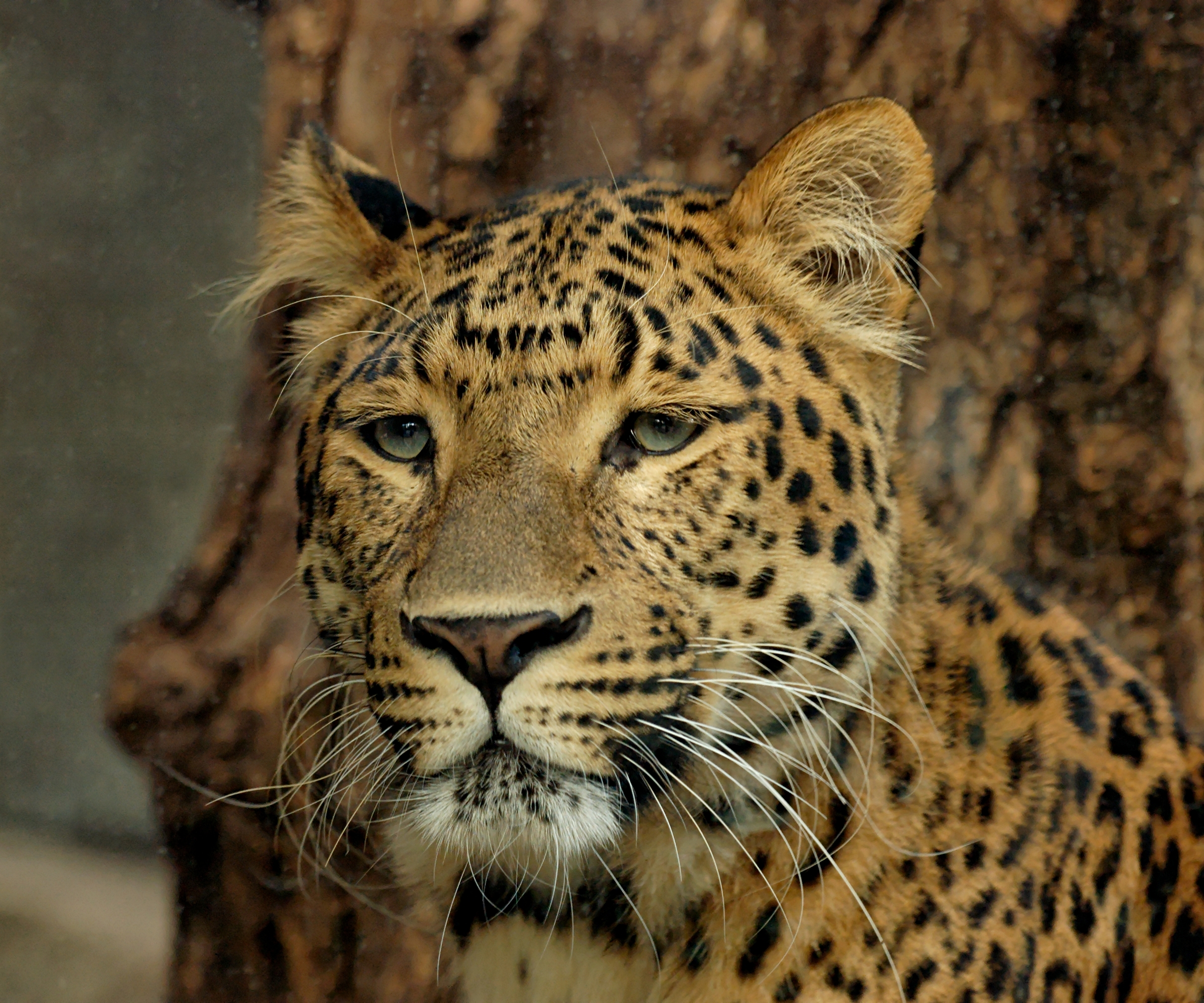 North
Chinese Leopard. Leopards evolved disruptive patterns designed to
provide concealment in foliage, the pattern is effective in grasslands
and rainforests (Public Domain by Marie-Lan Nguyen / Nikon D70).
Persian Leopard at Melbourne Zoo. Indigenous to the Caucasus, Turkey and Persia, these leopards evolved a much lighter coat to better adapt to the local environment (Image ¿ 2011 Carlo Kopp; Nikkor 70-300mm f/4-5.6D ED / D90). Snow Leopards evolved a light grey coat which is very effective disruptive camouflage in Central Asian mountainous terrain, dominated by grey rock formations. This example resides at Melbourne Zoo (Images ¿ 2011 Carlo Kopp; Nikkor 70-300mm f/4-5.6D ED / D90).   The
Cheetah is another ambush predator, which dashes from cover to run down
its prey. It evolved a spotted disruptive camouflage pattern, very
effective in grasslands. Depicted example at Werribee Zoo in Victoria (Images
¿
2011 Carlo
Kopp; Nikkor 70-300mm f/4-5.6D ED / D90).
 This image of a Sumatran Tiger shows the effectiveness of the Degradation Strategy as the characteristic striped disruptive camouflage emulates the shadows cast by foliage (Image ¿ 2011 Carlo Kopp; Nikkor 70-300mm f/4-5.6D ED / D90). 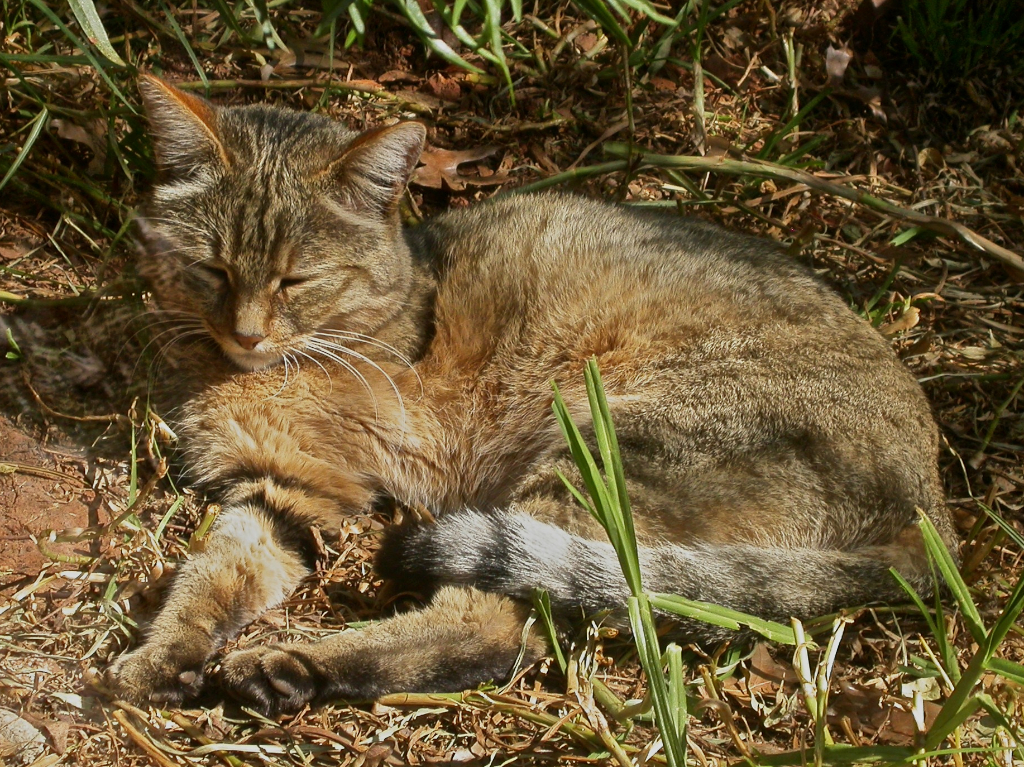 The African Wildcat (Felis silvestris lybica) is the ancestor of the domestic housecat (Felis silvestris catus), proven by the analysis of mitochondrial DNA (Driscoll et al, Science 317: 519–523). The disruptive camouflage patterns of these felines vary from tabby-like patterns, to more subdued and almost uniform coats, with tabby-like facial, tail and leg patterns. The habitat for the species in mostly grassland and brush, for which these patterns are well adapted (Sonelle, Creative Commons Licence).  European domestic cats (Felis silvestris catus) are descended from North African Wildcats (Felis silvestris silvestris/lybica), and the typical mackerel tabby pattern is shared by both, as well as European Wildcats. The pattern is seen with variations in coat colour, but is typically effective in grass, other foliage and woodland terrain (Images ¿ 2009 Carlo Kopp).  The effectiveness of any camouflage depends on the sensor it is intended to defeat. Rodents are the main diet of small felines, and rodents often have Red/Green deficient colour perception. Rats and mice have colour peaks at 359-360 nm in the near UV and 509-512 nm in the blue-green (Jacobs G.H. et al, 2001 & 2004). This image shows a classical mackerel tabby cat in the Red/Green/Blue colour bands, top, with suppressed Red/Green and enhanced Yellow/Blue bands, centre, and in monochrome, bottom (Images ¿ 2011 Carlo Kopp; Nikkor 70-300mm f/4-5.6D ED / D90).  Black cats, whether large or small, frequently display the same camouflage patterns as spotted or striped cats, but very subdued (Image ¿ 2009 Carlo Kopp). The African lion is unusual amongst the great cats in lacking a disruptive camouflage pattern. These examples are at Werribee Zoo (Image ¿ 2011 Carlo Kopp; Sekor C 45 mm f/2.8N + Fotodiox Pro adaptor / D90). The African Wild Dog is unusual amongst the canids in employing a disruptive camouflage pattern. These examples are at Werribee Zoo (Images ¿ 2011 Carlo Kopp; Nikkor 70-300mm f/4-5.6D ED / D90). Above:
Eastern
Grey Kangaroo at Melbourne Zoo;
Below: A
wild Eastern Grey Kangaroo at Cardinia Reservoir. The subdued grey or
red brown coats of kangaroos are similar to other herbivores and
intended to minimise contrast against typical backgrounds (Images ¿
2011 Carlo
Kopp; Nikkor 70-300mm f/4-5.6D ED / D90).
  The red-brown
coats commonly seen in kangaroo species are a direct adaptation to the
red dust and rock in Northern and Central Australia. Depicted a Barrow
Island Euro (Image ¿ 1979 Carlo Kopp; Exakta VX500 / Meyer-Optik
Görlitz 50mm f2.8).
 The Giraffe's
disruptive camouflage pattern emulates the shadow cast by tree foliage,
which is a good adaptation to the environment they survive in. This is
clearly intended to disrupt visual acquisition at long ranges (Image
¿
2011 Carlo
Kopp; Nikkor 70-300mm f/4-5.6D ED / D90).
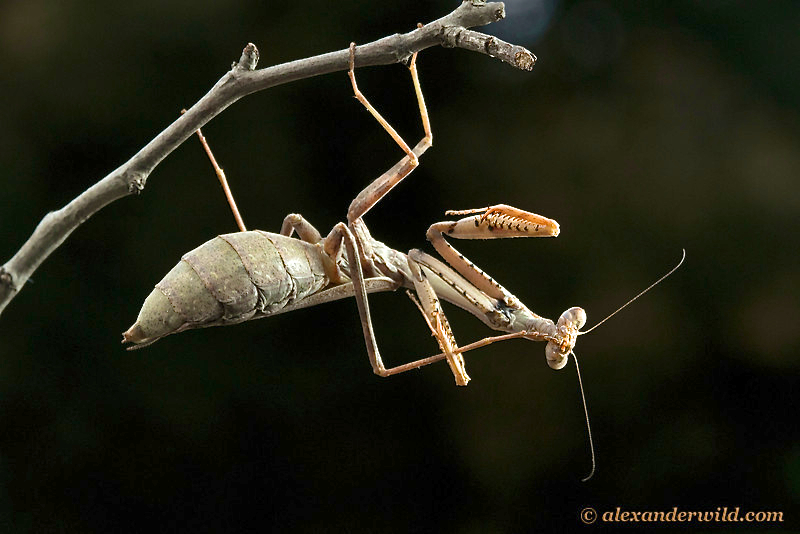 Mantids
are classical ambush predators which lie in wait for prey. They have
evolved diverse camouflage to adapt to local environments, emulating
most frequently forms of foliage (photo
by Alex Wild).
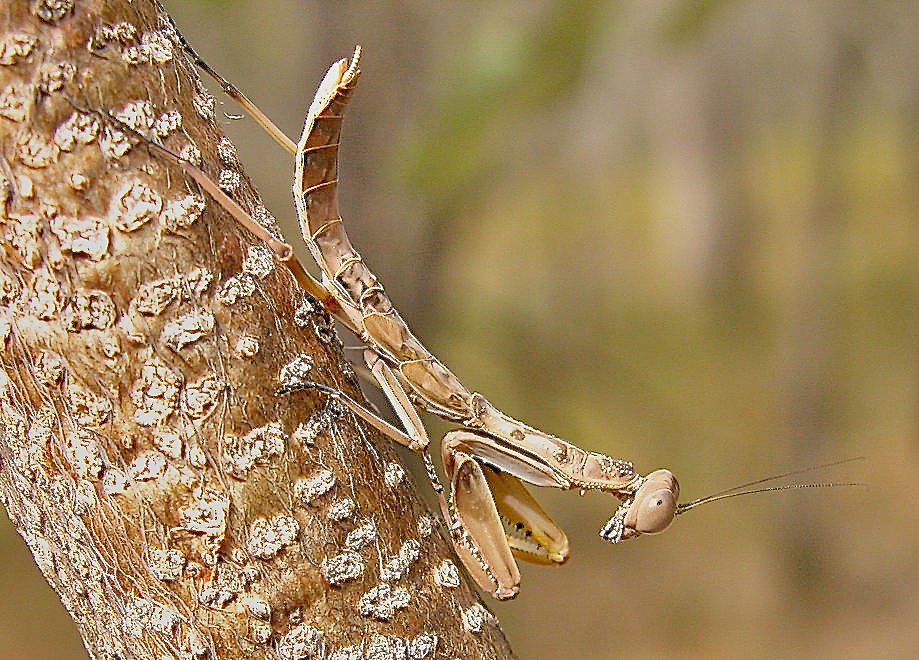 The Australian Burying Mantid Sphodropoda tristis, like many of its cousins globally, is exquisitely camouflaged to hide on dry bark (Images ¿ 2011 Peter Chen). 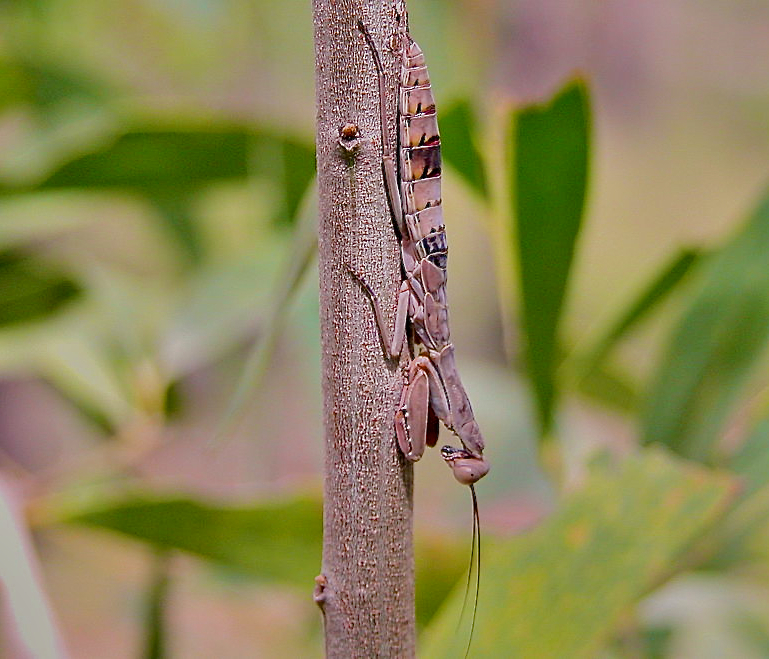  The
predatory West Australian Leafy Sea Dragon evolved a shape which
emulates the sea grass which forms its habitat. This example is at the
Acquarium of Western Australia (Image ¿ 2011 Carlo Kopp; Nikkor 35 mm
f/1.8G / D90).
 Ulysses
Swallowtail
at Melbourne Zoo. The iridescent turquoise
upper wings evolved for mating displays, but the lower wings perform
well as disruptive camouflage when the butterfly is resting (Image ¿
2011 Carlo
Kopp; Nikkor 70-300mm f/4-5.6D ED / D90).
Moths are nocturnal, and typically evolve effective camouflage to effect concealment from daylight predators (Image ¿ 2007 Carlo Kopp; Fuji S5600). The nocturnal Australian Tawny Frogmouth is camouflaged to resemble tree bark, and when threatened, remains perfectly still to confuse a predator. This example is at Healesville Sanctuary in Victoria (Image ¿ 2011 Carlo Kopp; Nikkor 70-300mm f/4-5.6D ED / D90).  Male and female
Australian Wood Ducks at Melbourne Zoo. Female birds are frequently
well camouflaged to minimise the probability of a nest being discovered
by predators or scavengers (Image ¿ 2011 Carlo Kopp; Nikkor
70-300mm f/4-5.6D ED / D90).
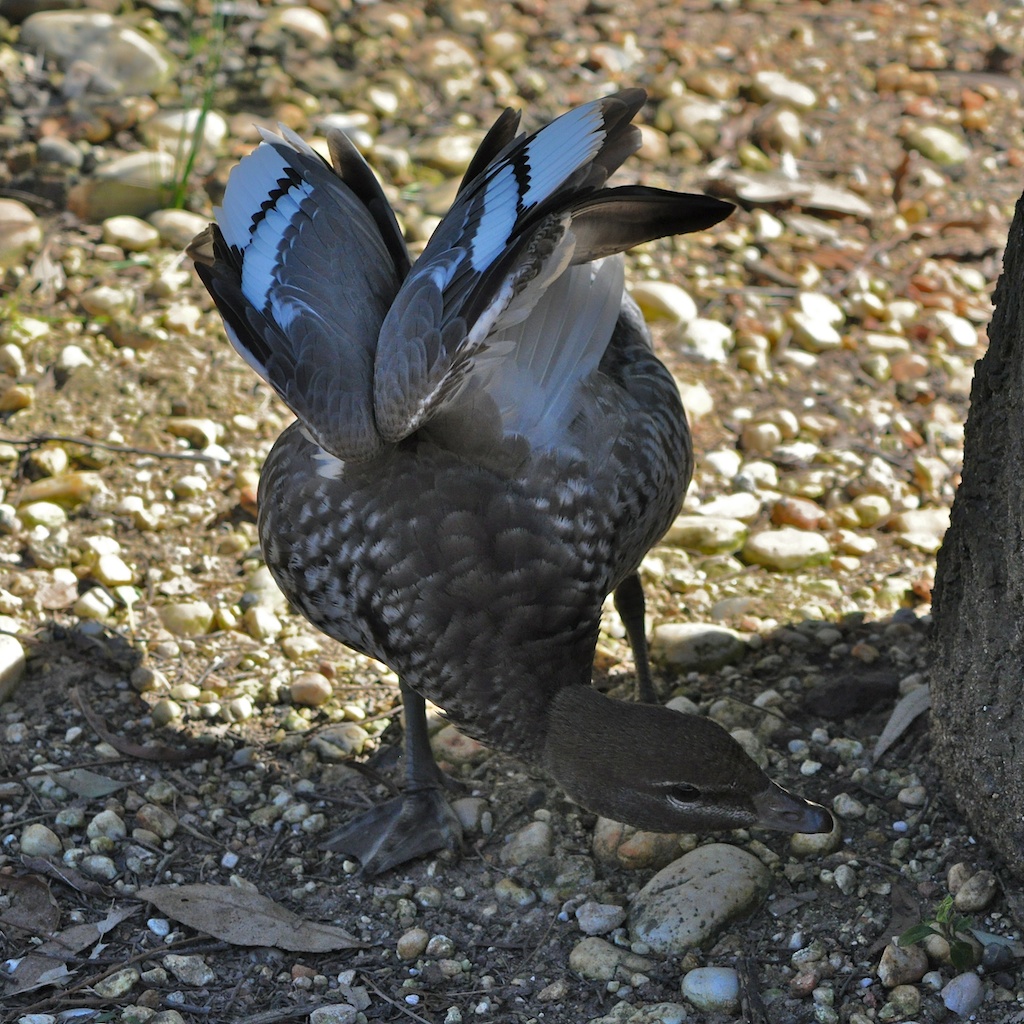  The Buff
Banded Rail employs a linear striped disruptive pattern which emulates
the contrast
pattern in grass, where the species frequently forages (Image ¿
2011 Chris Mills / Panasonic DMC-ZS7).
  Above and below: Rainbow Lorikeets destroying fruit in a Melbourne suburban plum tree. The camouflage is equally effective in fruit trees, as it is in eucalypts (Images ¿ 2012 Carlo Kopp; Nikkor 70-300mm f/4-5.6D ED / D90). Musk Lorikeets foraging in a eucalypt at Monash Uni Clayton Campus. The camouflage is almost perfectly adapted to the habitat (Image ¿ 2012 Carlo Kopp; Nikkor 70-300mm f/4-5.6D ED / D90).  A nectar
eating Musk Lorikeet foraging in a eucalypt at Monash Uni
Clayton Campus (Image ¿ 2012
Carlo Kopp; Nikkor
70-300mm f/4-5.6G / D90).
 Reptiles
frequently evolve elaborate camouflage. Depicted a predatory South
American Green Tree Boa at Melbourne Zoo (Images
¿ 2011 Carlo Kopp; Sekor C 45 mm
f/2.8N + Fotodiox Pro adaptor / D90).
The Coastal Taipan, above and below, evolved a subdued camouflage well suited to the undergrowth in which it hunts its prey (Images ¿ 2011 Carlo Kopp; Sekor C 45 mm f/2.8N + Fotodiox Pro adaptor / D90). Arboreal Eyelash Vipers from the rainforests of Latin America are very diverse in their disruptive camouflage patterns, this example is at Melbourne Zoo. They are typical ambush predators (Image ¿ 2011 Carlo Kopp; Nikkor 35 mm f/1.8G / D90). Herbivorous
Common Iguana at Melbourne Zoo (Image ¿ 2011 Carlo Kopp; Sekor C 45 mm
f/2.8N + Fotodiox Pro adaptor / D90).
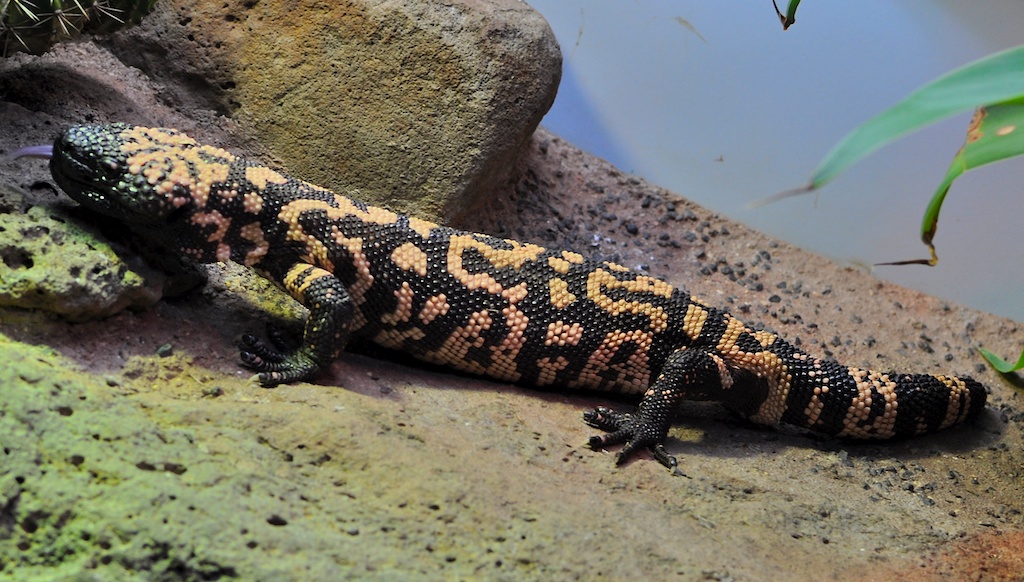 Gila
Monster with distinctive high contrast disruptive pattern, at
Melbourne Zoo (Image ¿ 2011 Carlo Kopp; Nikkor 35 mm
f/1.8G / D90).
Dragons comprise a respectable number of species, a large portion of which employ disruptive pattern camouflage (Image ¿ 2011 Carlo Kopp; Nikkor 35 mm f/1.8G / D90). |
|||||||||||||
|
The predatory Perentie
monitors of
Northern Australia display distinctive spotted disruptive camouflage
patterns well adapted
to their habitats. Above and below, Barrow Island Varanus giganteus (Images ¿ 1979
Carlo Kopp; Exakta VX500 / Meyer-Optik Görlitz 50mm f/2.8).
  The
Lace Monitor Varanus varius, above and below, is closely related to the
Perentie yet has evolved distinct banded disruptive camouflage
patterns, in two different forms, reflecting different habitats (Image
¿
2011 Carlo
Kopp; Nikkor 70-300mm f/4-5.6D ED / D90).
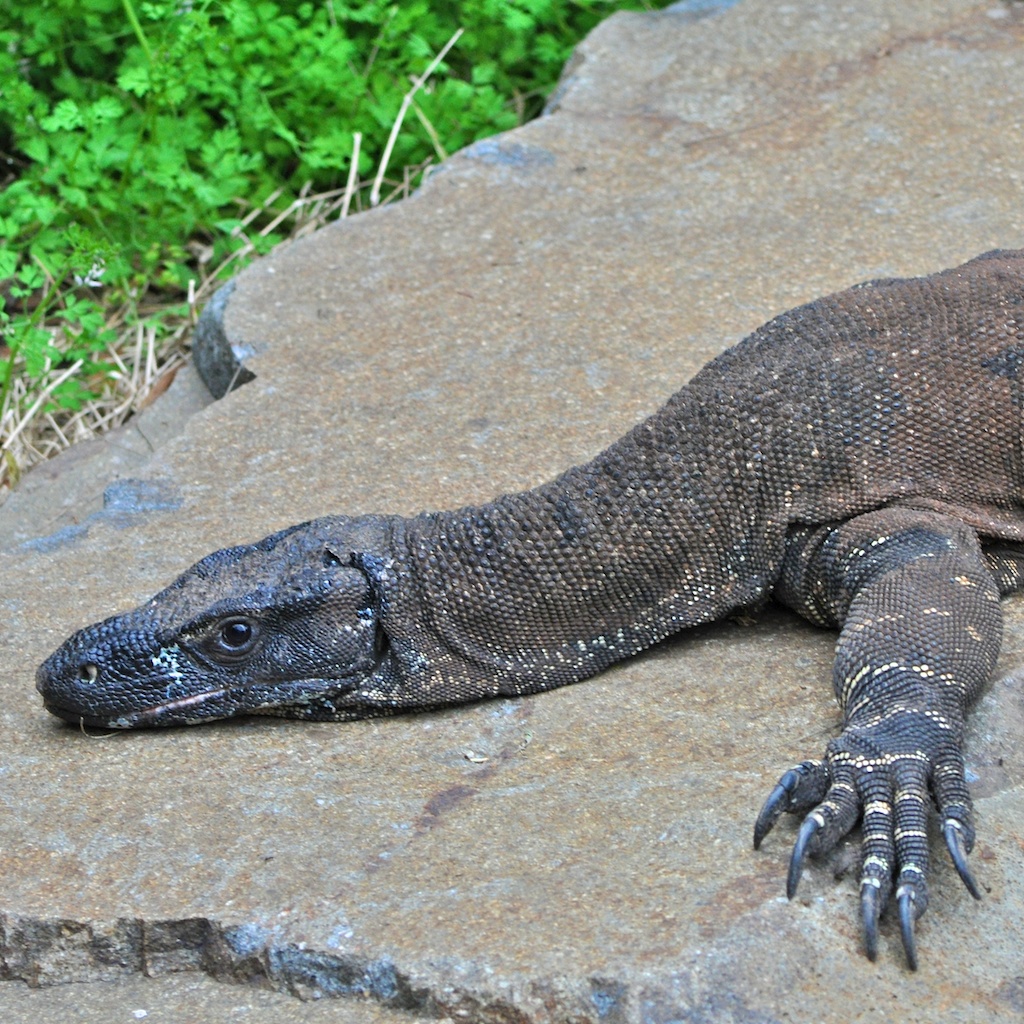  The Green Sea
Turtle is well camouflaged for it aquatic habitat (Image ¿ 1979 Carlo
Kopp; Exakta VX500 / Meyer-Optik Görlitz 50mm f/2.8).
 Bottom dwelling
fish frequently evolve effective caouflage for such habitats. Above
Three Shovel Nose Rays basking in 6 inch deep tidal flats, Below a
Stingaree and pair of Stingrays, all photographed on Barrow Island
(Images ¿ 1979 Carlo Kopp; Exakta VX500 / Meyer-Optik Görlitz 50mm
f/2.8).
  |
|||||||||||||
|
Corruption Strategy |
|||||||||||||
| Corruption [also Deception and Mimicry],
i.e. the insertion of intentionally misleading information; corruption
amounts to mimicking a known signal so well, that a receiver cannot
distinguish the deceptive signal from the real signal. Mimicry arises frequently in biology, the best examples being harmless organisms which masquerade as toxic or predatory organisms, to deter predators. |
|||||||||||||
|
|
|||||||||||||
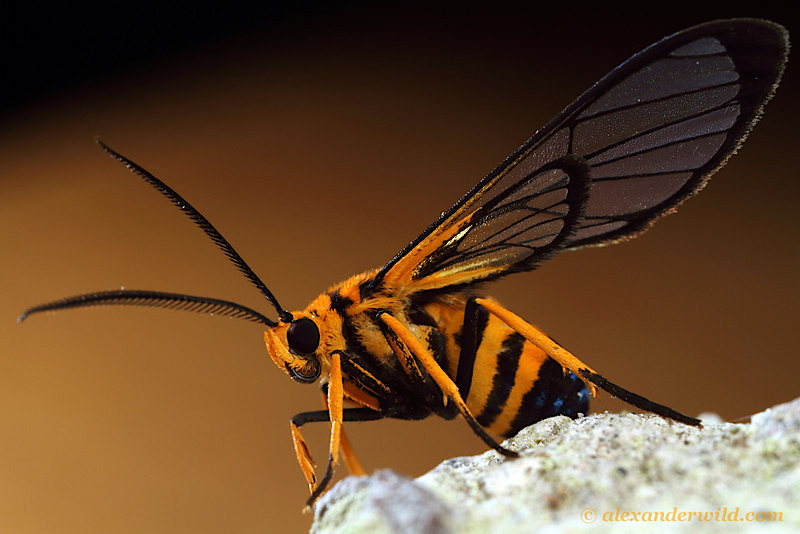 An outstanding example of wasp mimicry is
this Orange Wasp Moth (Cosmosoma ethodaea), photographed by Alex Wild
at the Maquipucuna reserve, Pichincha, Ecuador. Wasp mimicry is
surprisingly common in tropical day moths and there are many wasp
mimics evolved in the Arctiid family. The depicted species displays
mimicry in shaping, colour, and transparent wing membranes (photos
by Alex Wild).
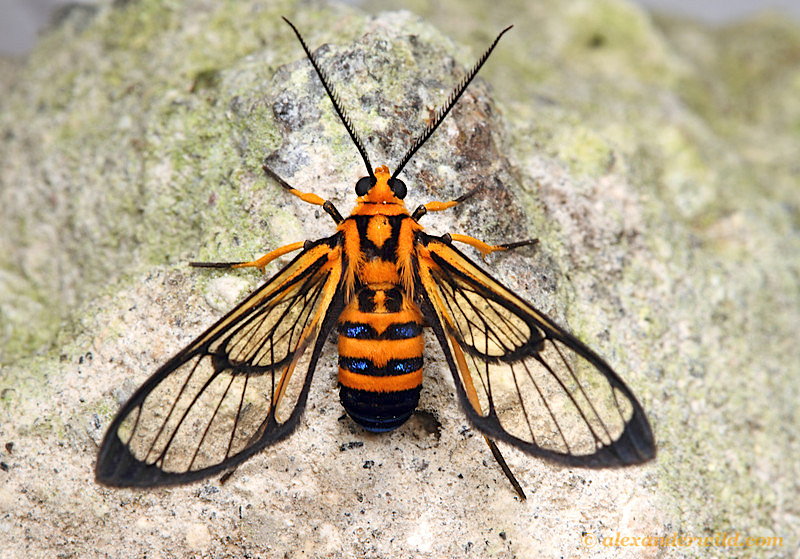 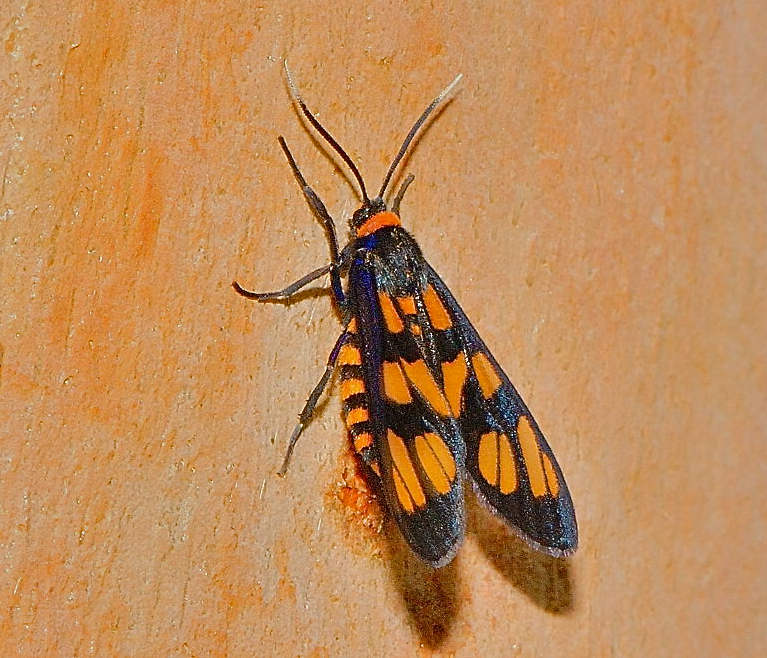 The Australian White Antenna Wasp Moth
(Amata nigriceps) is another Arctiid wasp mimic. This example was
photographed in Brisbane (Image
¿ 2011 Peter Chen).
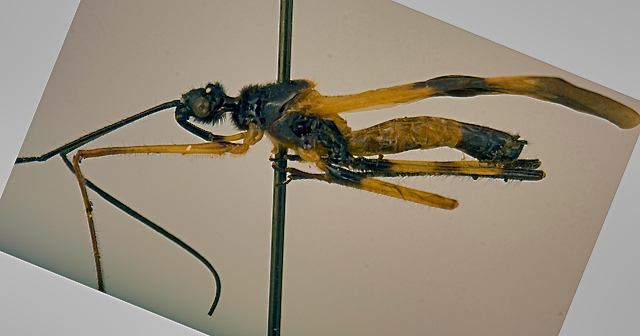 An
interesting wasp mimic is the Scaphura
katydid. The Hiranetis
braconoformis assassin bug (above) produces a remarkably good imitation
of the
Monogonogastra braconid wasp (¿
American Museum of Natural History / Discover Life ).
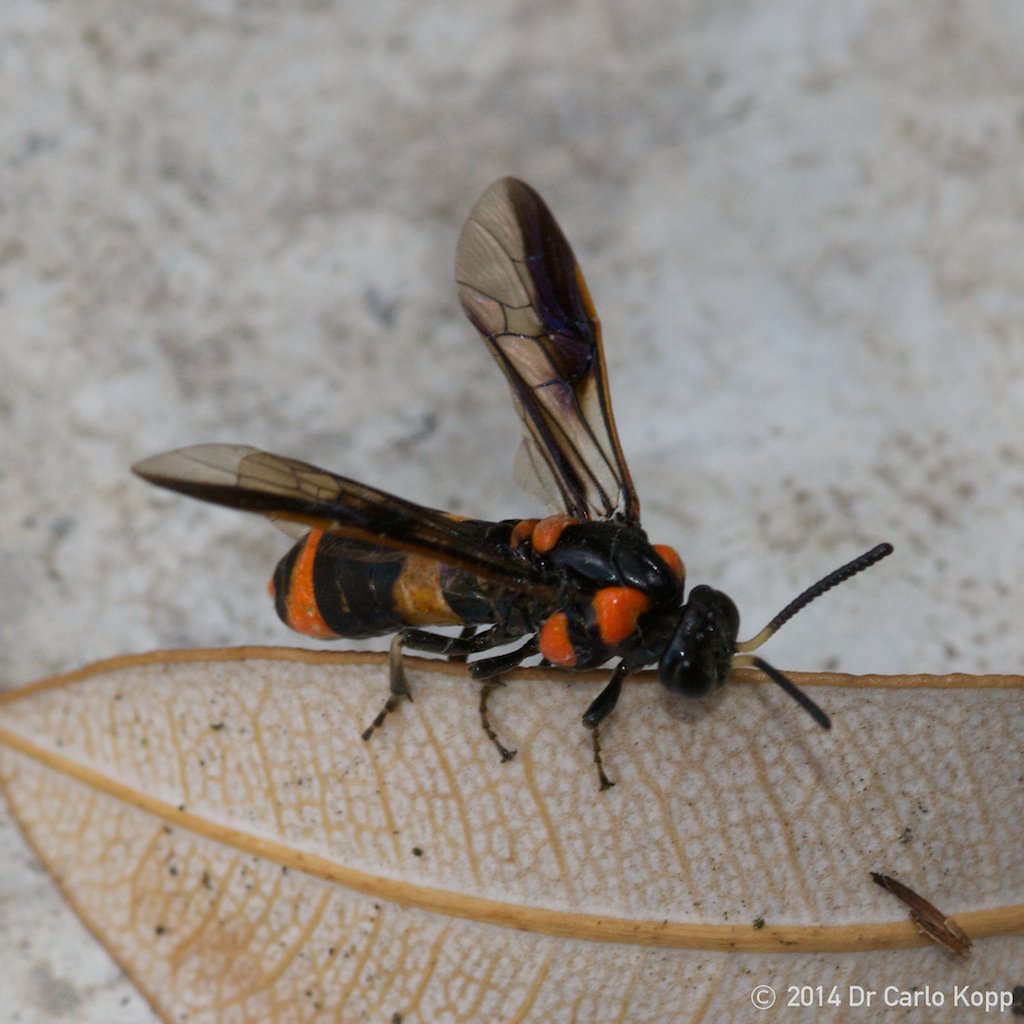 Another outstanding wasp mimic is the Bottlebrush Sawfly (Phylacteophaga cinctus), which is a close relative of wasps, bees and ants. This species emulates the common australian native potter wasps in colour and shaping features (Image ¿ 2014 Carlo Kopp; Sigma AF 105mm f/2.8 DG EX Macro / D7100).  The common yellow/black striped pattern employed by wasps and bees is intended to warn predators, and would qualify as non-deceptive Mullerian mimicry (Image ¿ 2011 Carlo Kopp; Nikkor 70-300mm f/4-5.6D ED / D90). 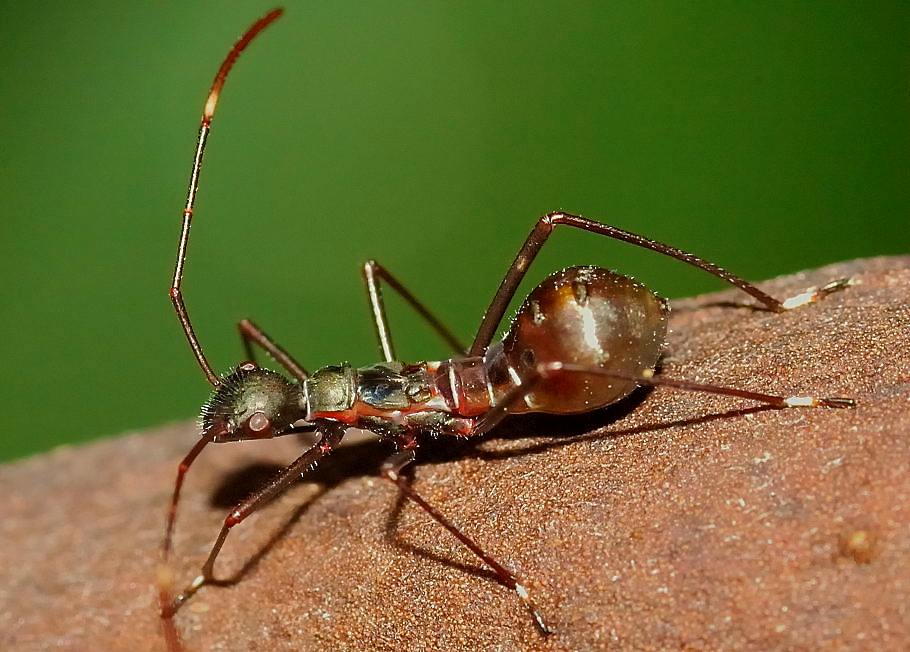 Ant mimicry is like wasp mimicry, a commonly evolved defensive feature, seen in a number of bugs, beetles, katydids and spiders. An example are nymphs of the Australian Riptortus serripes pod sucking bug, which emulate ants to discourage predators (Image ¿ 2011 Peter Chen). 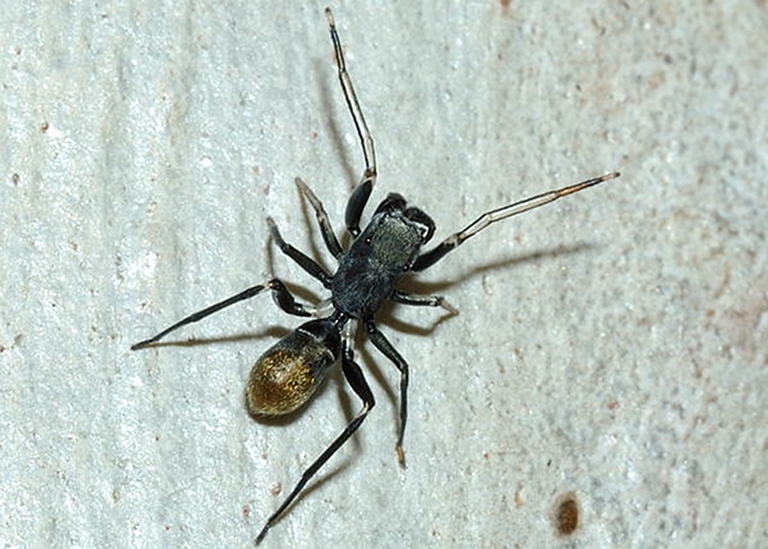 The Australian
Myrmarachne jumping spider mimics the Golden Ant (Image
¿ 2011 Peter Chen).
Some other interesting examples of ant mimicry can be found at Peter Chen's Myrmecomorphy webpage. 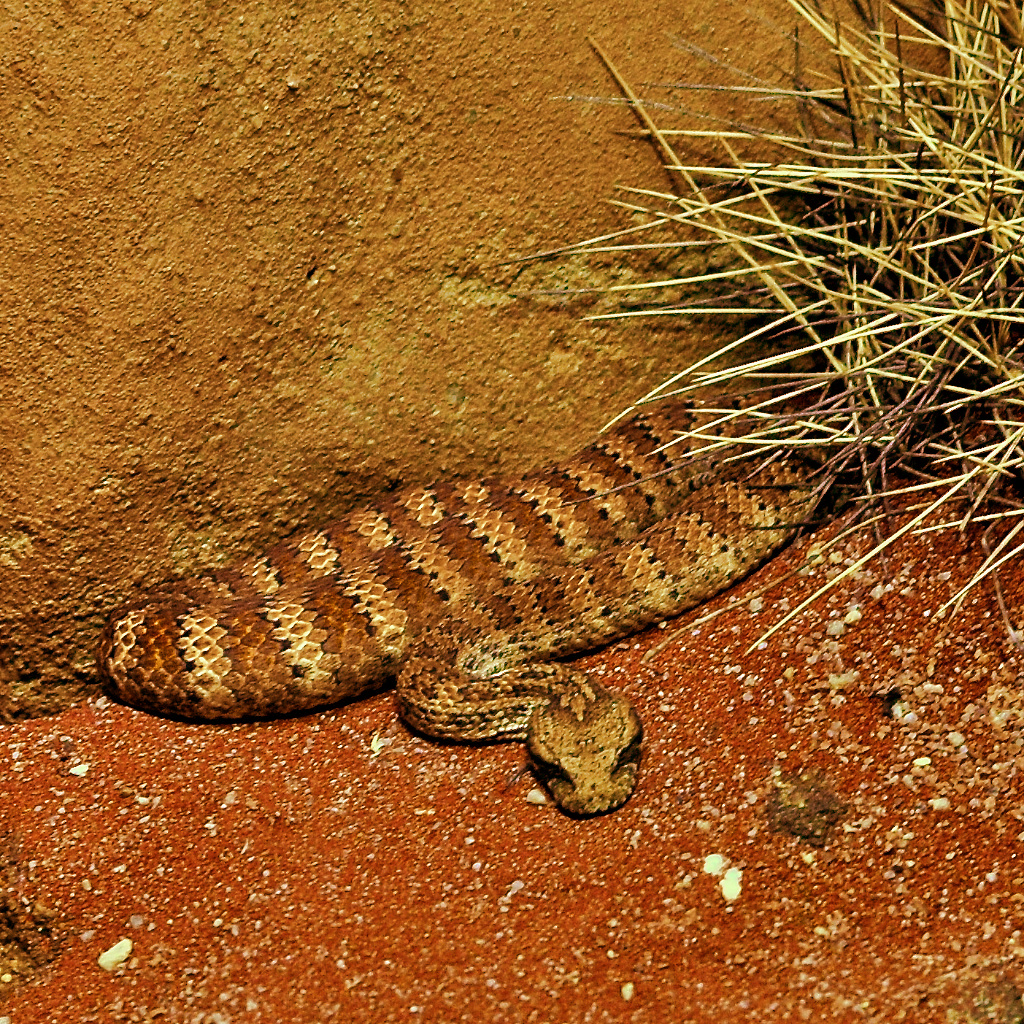 The Australian
Death Adder uses its tail as a lure to seduce prey into striking range.
Its concurrent use of a disruptive camouflage pattern presents as a
compound use of Degradation and Corruption strategies (Image ¿
2011 Carlo Kopp; Nikkor 35 mm
f/1.8G / D90).
|
|||||||||||||
|
Denial Strategy [Disruption] |
|||||||||||||
|
Denial [also Disruption and Destruction],
i.e. the insertion of information which produces a dysfunction inside
the opponent’s system; alternately the outright destruction of the
victim receiver subsystem; Denial via disruption or destruction amounts
to injecting so much noise into the channel, that the receiver cannot
demodulate the signal, or rendering the receiver permanently or
temporarily
inoperative.
|
|||||||||||||
|
|
|||||||||||||
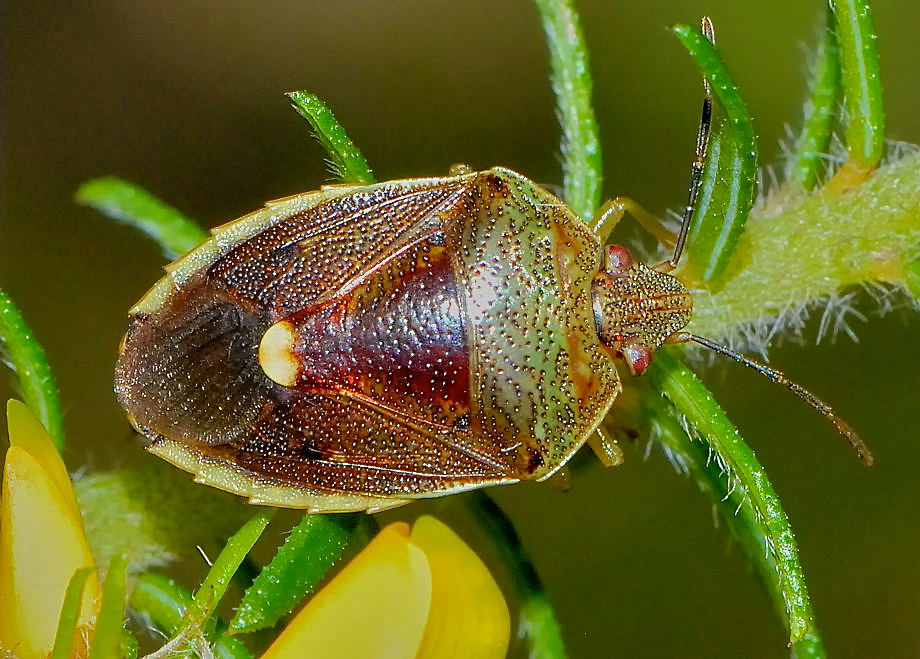 Aptly named, stink bugs emit a noxious fluid when threatened, which disables the attacker's olfactory organ, denying its use in hunting the stink bug. Above is the Phyllota Stink Bug (Ocirrhoe dallasi), below the Green Jewel Bug (Lampromicra senator), both found in Brisbane, Australia (Images ¿ 2011 Peter Chen). 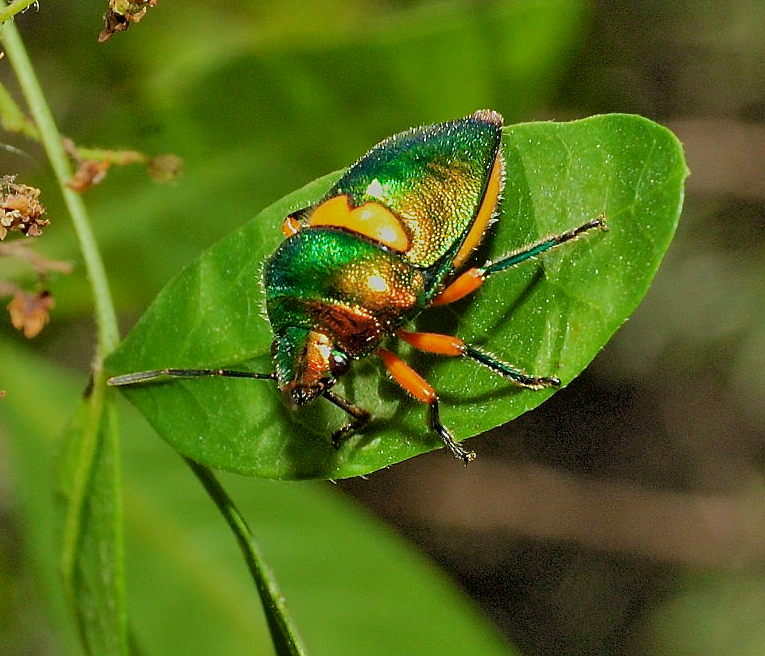 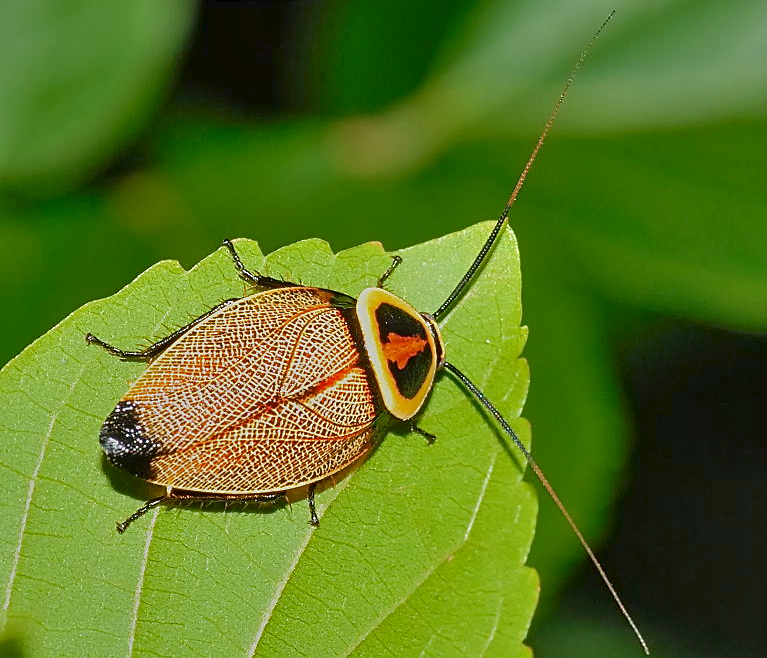 Many cockroach species emit eject a noxious fluid when disturbed, some to a distance of up to a metre (e.g. a Spinifex roach observed by this author in 1980). Depicted is the Ellipsidion australe in Brisbane (Images ¿ 2011 Peter Chen). 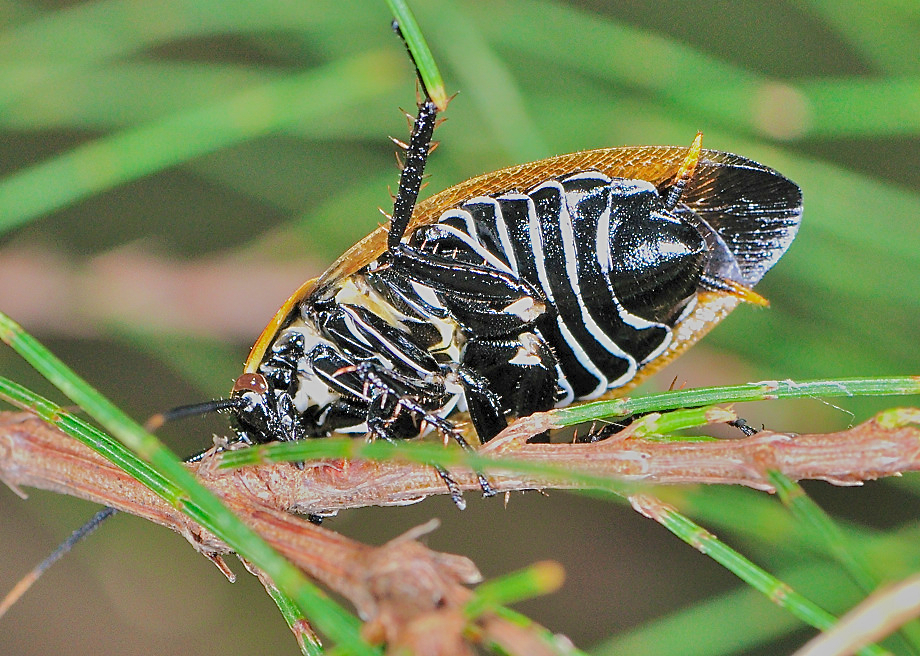 Cuttlefish are well known for their to
ability blind predators by
discharging a cloud of ink. Depicted is the Sepia latimanus or Reef
cuttlefish (Nick
Hobgood).
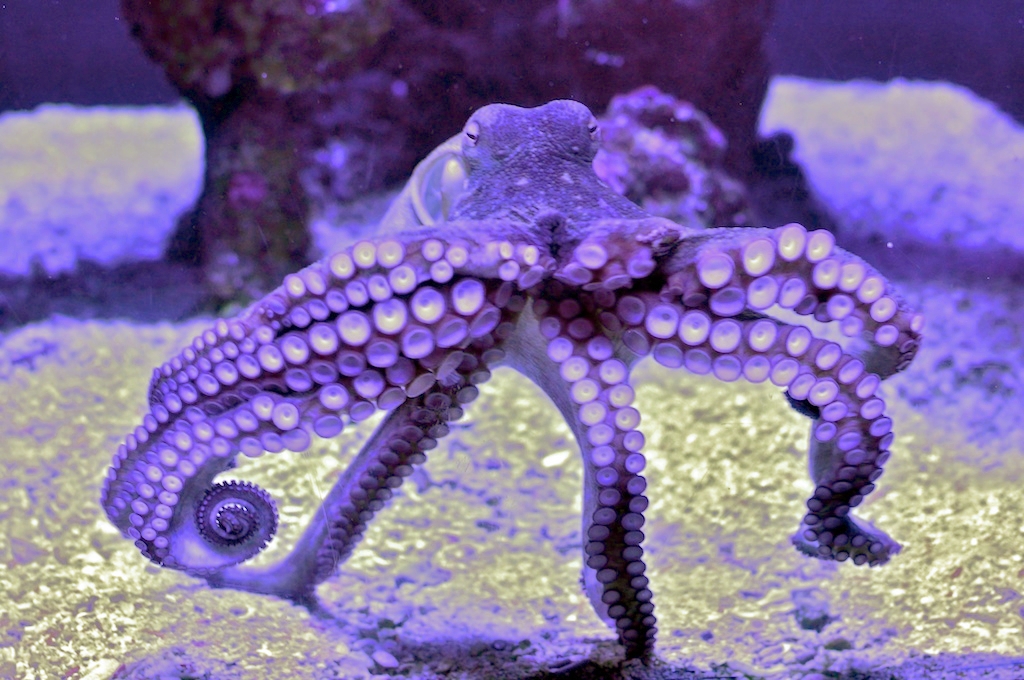 Like the cuttlefish, this Gloomy Octopus can discharge ink to blind a predator, but can also alter its skin colour to optimise camouflage performance. This example is at the Acquarium of Western Australia (Image ¿ 2011 Carlo Kopp; Nikkor 35 mm f/1.8G / D90). |
|||||||||||||
|
Denial Strategy [Subversion] |
|||||||||||||
|
Denial [also Subversion], i.e.
insertion of information which triggers a self destructive process in
the opponent’s target system; Denial via subversion at the simplest
level amounts to the diversion of the thread of execution within a
Turing machine, which maps on to the functional behaviour of the victim
system, i.e. surreptitiously flipping specific bits on the tape, to
alter the behaviour of the victim Turing machine.
|
|||||||||||||
|
Bothriomyrmex regicidus.
Queens of these ‘cuckoo’ ant species will invade another ant colony,
kill the queen and seduce the colony worker ants into rearing the
usurper’s brood (Image
April Nobile / ¿ 2000-2009 AntWeb.org).
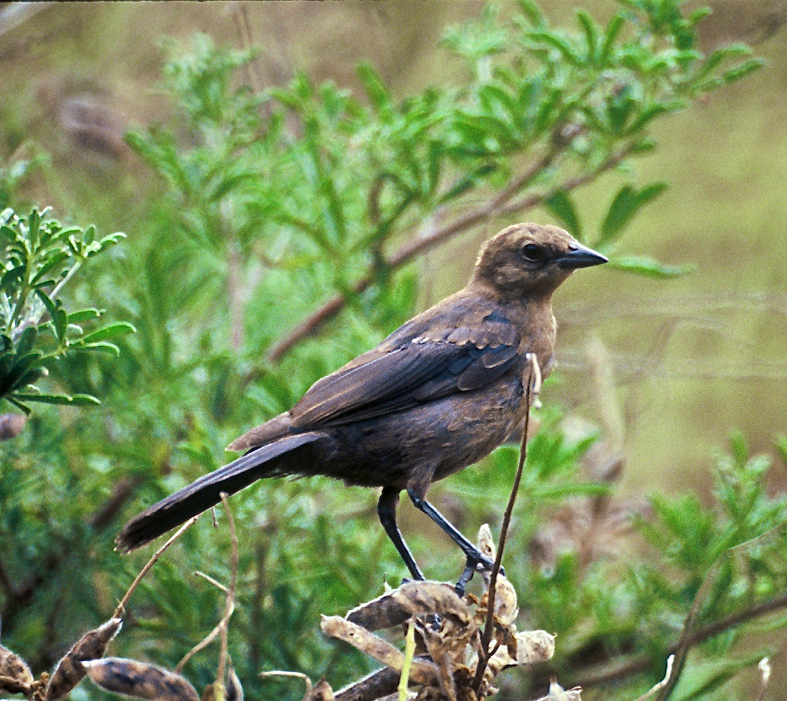 Molothrus ater. The brown-headed cowbird can elicit preening behaviour from bird species which do not typically preen. This is an example of denial/subversion, as the victim bird wastes time preening its attacker (while superficially benign, this is an attack, since the victim bird species is wasting time and energy doing the preening), a behaviour that is not a part of its established repertoire. The parasitic behaviour of the cowbird extends further, as like cuckoos it lays its eggs in other species' nests (Image USFWS). |
|||||||||||||
|
Deception in Biology Nature's Exploitation of Information to Win Survival Contests |
|||||||||||||
| ¿ 2011 - 2014 Carlo Kopp / Monash
University
|
|||||||||||||
|
|||||||||||||||
| Artwork and text ¿ 1994 - 2010 Carlo Kopp; All rights reserved. |
| $Revision: 2.279 $ |